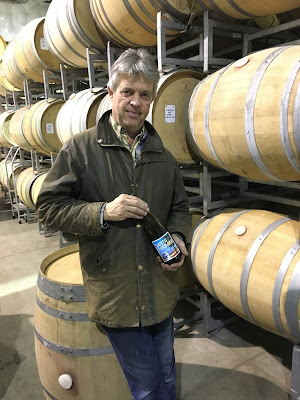story published in the Santa Barbara News-Press on 1/28/16
 |
| Karen Steinwachs (Bob Dickey photo) |
For
winemakers like Karen Steinwachs, being small is a big deal. “I’m definitely a garagiste,” she tells
me. “Actually, more like a
micro-garagiste,” since her Seagrape label puts out a mere 300 cases of wine a
year.
The word,
garagiste, was once used derogatorily.
Established French producers would use it to insult the little guy – the
small-lot producer who did his own thing, pushed the envelope and bent the rules
of the trade – and who often worked out of his garage.
Today, for a
growing movement of winemakers around the world, the term is worn like a badge
of honor. Yes, their size is almost
always a product of necessity. These personal
passions are largely self-funded – people entering an industry notorious for
both its prohibitive costs and its very crowded field. Starting small is cheaper.
But in that
creative winemaking arena – in that world of wines that are hand-crafted,
hand-held and hand-sold – ideas tend to flow more freely, creativity tends to
fester and experimentation tends to reign supreme. As such, being a garagiste becomes a lot less
about size and more about the idea that even the oldest of traditions – making
wine – can see new and exciting interpretations.
That premise
gave birth to the Garagiste Festival four years ago, creating a platform where
small-lot California winemakers and curious consumers can meet and mingle. Today, the tasting takes place three times a
year, in Paso Robles, Los Angeles and Solvang.
The 2016 “Garagiste Festival: Southern Exposure” event comes to
Solvang’s Veterans Memorial Hall next month, on Valentine’s Weekend, February
13 and 14.
 |
| Solvang's Veterans Memorial Hall hosts Garagiste Festival: Southern Exposure |
The majority
of the labels that pour at Garagiste don’t have tasting rooms, many don’t have
distributors. So a focused tasting event
with the right crowd can do a lot to boost visibility and sell wine. But the consumer may be the bigger winner
here. These wines are tough to find,
either at wine shop shelves or even other events. The organizers do a nice job of making things
intimate and approachable: only 25 wineries pour each day, so you can visit
them all. Each day features a different
set of wines. And since only the owner
or winemaker, herself, is doing the pouring, it’s easy to engage them and to
speak one-on-one. This is the best way
to learn about new trends, and fresh approaches.
“I take more
chances with mine,” says Steinwachs. She’s
comparing her own Seagrape label, with its 300 cases, to her job as head winemaker
for the award-winning Buttonwood label.
She produces 8000 cases of wine a year there.
“Like stem
inclusion, which is sort of a geeky thing and not everybody likes it. If I’m making a Buttonwood wine, I might do
20% stem inclusion, for a style that’s more palate-pleasing, but I might go 80%
for Seagrape, a bit bigger. And our
chardonnay has a little bit of oak in it, because I like oaked chardonnay. So with Seagrape I can dabble more.”
Steinwachs,
who launched Seagrape in 2007 with her late husband, Dave Robinson, is pouring
yet-unreleased wines at next month’s Garagiste.
 |
| Larry Schaffer (Bob Dickey photo) |
Winemaker
Larry Schaffer’s project has certainly grown since 2006, when the Tercero label
hit the market with a whopping 100 cases.
At somewhere above 2000 cases now, he’s one of the largest Garagiste
participants. The event actually
requires members make 1500 cases a year or less; Schaffer has been sort of
grandfathered in. “I still have the
mindset of a garagiste,” he insists. In
fact, one of his best wines, a fragrant and bouncy gewürztraminer, is called
The Outlier.
On Saturday,
Schaffer will be heading a seminar on mourvedre, a Rhone grape that he loves
for its potential as a blending agent, a rosé or a stand-alone wine. “It can be made into a multitude of styles,
and it can really show sense of place,” he says. A warmer climate can yield fruit-forward
mourvedre wines, he adds, while a cooler clime can make them earthier. The seminar, which will also focus on the
history of mourvedre, will also feature Zaca Mesa winemaker Eric Mohseni and
Atla Colina’s Bob Tillman. It runs from
11:30am-12:30pm. The Grand Tasting goes
from 2pm (1pm for Early Access) to 5pm.
A VIP
All-Day Access ticket, which includes the seminar, lunch and tasting, costs
$95. The tasting alone costs $55 ($75
for 1pm Early Access). Two-day passes
reflect a 20% discount.
The times
are the same on Sunday, which is Valentine’s Day; that day’s seminar is on
sparkling wine and will feature Flying Goat’s Norm Yost, Kessler-Haak’s Dan
Kessler and Halcyon Wine’s Tyler Elwell, a buzzed-about up-and-comer.
But no
matter which day you go – go both! – Schaffer insists this is a boon for
consumers. “These winemakers are
stretching their wings, starting off in new adventures, possibly doing things
differently, working with different vineyards,” he tells me. “More experimentation doesn’t mean the wine
is better or worse. But you don’t know
until you try it, and this event affords consumers that. And they are very likely to find something
they really like.”
For more
information on “Garagiste Festival: Southern Exposure,” including a couples’
discount for Valentine’s Day and overnight stay options, go to
garagistefestival.com.
###













